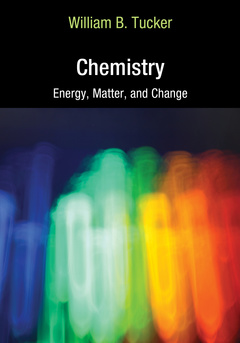Description
Chemistry
Energy, Matter, and Change
Language: English
Subjects for Chemistry:
Publication date: 07-2024
· 17.8x25.4 cm · Paperback
Publication date: 07-2024
· 17.8x25.4 cm · Hardback
Description
/li>Contents
/li>Readership
/li>Biography
/li>
Providing a holistic overview of general chemistry and its foundational principles, this textbook is an essential accompaniment to students entering the field. It is designed with the reader in mind, presenting the historical development of ideas to frame and center new concepts as well as providing primary and summative sources for all topics covered. These sources help to provide definitive information for the reader, ensuring that all information is peer-reviewed and thoroughly tested.
Features:
? The development of key ideas is presented in their historical context.
? All information presented is supported through citations to chemical literature.
? Problems are incorporated throughout the text and full, worked-out solutions are presented for every problem.
? International Union of Pure and Applied Chemistry style and technical guidelines are followed throughout the text.
? The problems, text, and presentation are based on years of classroom refinement of teaching pedagogy.
This textbook is aimed at an advanced high school or general college audience, aiming to engage students more directly in the work of chemistry.
Contents
Introduction
Attribution
Acknowledgements
Creative Commons License
Chapter 1 Introduction, sustainability, conventions, and writing
Chapter 2 Energy
Chapter 3 Atoms
Chapter 4 Binding energy, nuclear stability, and decay
Chapter 5 Nuclear reactions
Chapter 6 Light and electrons
Chapter 7 Electrons and quantum numbers
Chapter 8 Periodic trends
Chapter 9 Bonding
Chapter 10 Molecular shapes
Chapter 11 Gases
Chapter 12 The van der Waals equation and intermolecular forces
Chapter 13 States, phases, and physical changes
Chapter 14 Chemical kinetics
Chapter 15 Enthalpy
Chapter 16 Entropy
Chapter 17 Gibbs energy
Chapter 18 Equilibrium
Chapter 19 Electron transfer
Chapter 20 Electron sharing
Appendices
Answers to in-text problems
William Tucker's passion for chemistry was inspired by his high school teacher Gary Osborn. He left Maine to pursue Chemistry at Middlebury College, and after graduating in 2010 he decided to pursue a Ph.D. in Organic Chemistry at the University of Wisconsin-Madison. At the University of Wisconsin-Madison, he worked in the laboratory of Dr. Sandro Mecozzi, where he developed semifluorinated triphilic surfactants for hydrophobic drug delivery. After earning his Ph.D. in 2015, he took a fellowship at Boston University as a Postdoctoral Faculty Fellow. There he co-taught organic chemistry while working in the laboratory of Dr. John Caradonna. In the Caradonna laboratory, he worked on developing a surface-immobilized iron-oxidation catalyst for the oxidation of C・H bonds using dioxygen from the air as the terminal oxidant. Throughout all of this work, his passion has always been for teaching and working with students both in and out of the classroom. He has been lucky for the past six years to work at Concord Academy, where his students have, through their questions, pushed him to think deeper and more critically about chemistry. Their curiosity inspires him, and their inquisitiveness inspired his writing.




